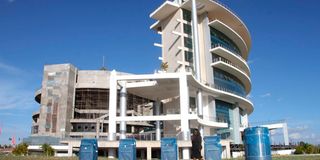Konza introduces Africa’s first automatic waste collection system

Anne Musyimi, the manager in charge of physical planning, compliance and environment at the Konza Technopolis, walks across a set of garbage bins at the city on February 10, 2025. The smart city has completed an innovative waste collection system which does not use trucks.
What you need to know:
- The Sh1.165 billion waste collection system places the development among the world’s most advanced cities.
As Konza Technopolis takes shape with the completion of its horizontal infrastructure, attention has shifted to the innovative amenities that define this Vision 2030 flagship project.
At the forefront is a groundbreaking Sh1.165 billion waste collection system that places the development among the world’s most advanced cities.

Anne Musyimi, the manager in charge of physical planning, compliance and environment at the Konza Technopolis, during the interview.
“The Konza Technopolis automatic solid waste collection system is the first of its kind in Africa,” explains Alice Obota, an electrical engineer who helped install and commission the system.
“The technopolis does not need trucks to collect waste. The automatic system can collect all the waste within an hour, processing up to 40 tonnes daily using pneumatic pressure technology.”
The system, developed by Spanish company Envac, represents a significant leap forward in urban waste management. It consists of 100 waste inlets strategically placed near residential areas and office buildings.
These modern disposal units, grouped in sets of four, replace traditional garbage bins and connect to an elaborate 14.8-kilometre underground pipeline network. The network converges at a central waste terminal in the heart of the 5,000-acre development, which spans the borders of Kajiado, Machakos, and Makueni counties.
How the system works
Users separate their waste into four categories at source: plastics, papers, mixed waste, and organic materials, depositing each type into designated inlets. When a bin reaches capacity, sensors trigger an automatic suction mechanism, drawing the waste through the pipeline network at 70 kilometres per hour to the central terminal.
The automatic waste collection system is designed to minimise stench associated with waste.
“The entire system is airtight to prevent odours from escaping into the environment,” Ms Obota explains. “Industrial filters at the terminal clean the air used for waste transport before release into the atmosphere. The airtight design also prevents pests from accessing the waste. At the terminal, each waste stream is separately compacted to minimise space requirements before being stored in special containers for recycling.”
Environmental impact
With the system, Konza has distinguished itself from other urban centres in the region that are grappling with waste collection challenges.
For instance, Nairobi City alone generates over 3,000 tonnes of solid waste daily, with overflowing litter bins and garbage heaps highlighting the inadequacies of traditional waste management infrastructure.
The problem largely stems from inadequate waste management infrastructure and lack of sufficient resources. This exposes urban residents to environmental degradation, public health hazards and economic loss associated with inadequate waste management.
“Traditional truck-based collection systems emit substantial carbon into the atmosphere, therefore causing a lot of pollution. Konza’s automatic system saves 89 tonnes of carbon emissions annually while addressing urban sanitation challenges,” notes Ms Obota
Broader sustainability initiatives
Anne Musyimi, the architect in charge of physical planning, compliance, and environment at Konza Technopolis, emphasises that the waste collection system is part of a comprehensive sustainability strategy.
Other development features at the Konza Technopolis include city and nature parks, a 30-acre solar farm, water recycling systems for greening initiatives, North-South building orientation for optimal environmental performance and a tree nursery capable of producing 10 million seedlings
“We prioritise environmental sustainability at Konza Technopolis,” Ms Musyimi explains.
“We are using treated wastewater that meets the World Health Organization drinking water standards to create tree-lined roads with 70 per cent canopy coverage. This encourages residents to walk rather than drive within the technopolis.”
Future development
The development plans include a waste-to-energy factory among its investment opportunities.
“We can run the city exclusively on renewable energy through our planned waste-to-energy plant, solar farm, and potential wind energy projects,” says Ms Musyimi.
During a recent visit, Dr David Ndii, leading a team of presidential economic advisors, endorsed the project as a model for sustainable urban development. “In terms of urban planning and development, I want to tell governors and city managers that this is the place you need to benchmark. You really do not need to go anywhere else to see what sustainable urban development is going to look like in the future.”
The Konza Technopolis project demonstrates how innovative technology can address urban challenges while promoting environmental sustainability, setting a new standard for city development in Africa.


